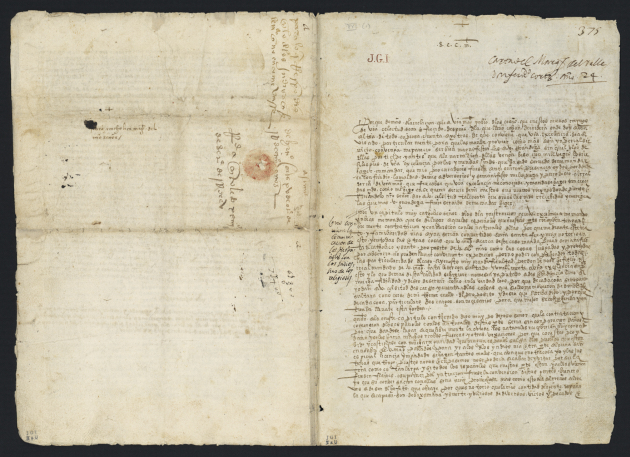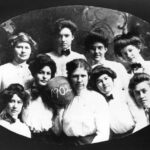Nettie Lee Benson Latin American Collection Celebrates 100 Years at UT

Sitting at a table at Sid Richardson Hall on campus, I lean over and try to look as closely as possible to a hundreds-of-years-old document while also trying not to breathe on it. “Is that…?”
I fail to finish my thought, in awe of the detail and precision on display. I’m at the Nettie Lee Benson Latin American Collection, looking at a map from 16th century New Spain—colonized Latin America—drawn primarily by indigenous artists for the king of Spain as part of a series of questionnaires the king sent to every town under his domain. This collection of maps, titled “Relaciones Geográficas,” is one of numerous collections of artifacts, materials, and resources the collection has to offer.
The Benson, named after former director Nettie Lee Benson, BA ’29, MA ’36, PhD ’49, Life Member, Distinguished Alumna, who was known for her deep-seated passion for Latin American history and culture, is one of the largest collections of Latin American and U.S. Latino materials the world. Rivaled in size only by Berlin’s Ibero-Amerikanisches Institut, the Benson is the premier library in the United States on everything Latin American, with over a million books in its circulating collection and miles of archival materials. Open to anyone, the collection holds everything from digitally preserved Latin American archives previously in danger due to environmental or political conditions to the first dictionary published in the Americas.
Three years ago, I was accepted to The University of Texas’ Teresa Lozano Long Insititute of Latin American Studies (LLILAS), which is housed in the same building as the Benson Collection and deeply tied to its identity and resources. I was admittedly unaware of the significance the collection held in the world of Latin American academia. As a Latin American Studies freshman, I had no idea I was sitting in class just a few floors above one of the most impressive libraries in the United States. Only when I began spending more time studying its resources did I begin to realize the collection’s magnitude.
The library was founded in 1921, known then just as the Latin American Collection, with the purchase and assemblage of seven train cars’ worth of materials from Mexico City, transported to UT’s campus in 1921. This collection, the Genaro García, was processed and held in the Architecture Library, which at the time was the main UT library. Adrian Johnson, UT Libraries’ head of user services, is somewhat of an expert on the Benson Collection.
Johnson says when they began processing the Genaro García collection, library staff realized how important it was for the study of Latin America, specifically Mexico. The president of the university at the time, Robert Ernest Vinson, decided to continue collecting materials important to Mexico, an initiative that quickly expanded to all of Latin America.
Johnson is quick to rattle off highlights of the Benson’s extensive collection, emphasizing the range, value, and significance of its artifacts.
The majority of the “Relaciones Geográficas,” the maps of 16th century Latin America I was trying not to breathe on, are in the archive of the Indies in Seville, Spain, Johnson says, but the Benson has a small collection of them.
Another highly valued artifact, Johnson says, is the handwritten autobiography of Antonio López de Santa Anna, the former president of Mexico who fought his way into history textbooks as the Mexican general on the other side of the Texas Revolution and the Mexican-American War.
“Students always know him as the bad guy of the Alamo,” Johnson says. “What many students don’t know is he was president of Mexico 11 times, and he went into exile many of those times, but he just kept making these comebacks. He’s one of the most complicated figures in Mexican history.”
The Benson Collection also holds a letter that is more than 470 years old from Hernán Cortés, the Spanish conquistador you may remember from sixth grade history who conquered the Aztecs in Tenochtitlan, now Mexico City, in 1521.
There’s no end to the number of invaluable artifacts. Some are colonial documents, but Johnson mentions that the collection extends all the way through the present too. For U.S. Latino populations, the Benson Collection is the official archive of LULAC, the League of United Latin American Citizens. “That’s kind of like the equivalent of the NAACP for Latino populations,” Johnson says.
The Benson Collection is preparing to celebrate its centennial in 2021. One hundred years after acquiring its first collection, the library has built itself into a Latin American institution.
Ryan Lynch, the head of special collections and senior archivist at the Benson Collection, says the centennial is the perfect time to reflect on the institution’s first century and look to its future.
“It’s an opportunity to not just rest on our laurels,” Lynch says, “but look at how we’ve changed and then to think about what the next hundred years will bring. I firmly believe that the Benson will still be known as a worldwide, premier collection of Latin American, U.S. Latino, and black diasporic scholarship, research and teaching.”
A letter from Hernán Cortés to Emperor Carlos V on Oct. 15, 1524. It is the first record of Cortes describing the Spanish encomienda system, in which a Spanish encomendero was granted a number of native laborers who would pay tributes to him in exchange for his protection.
Credit: Joaquín García Icazbalceta Manuscript Collection, Benson Latin American Collection, LLILAS Benson Latin American Studies and Collections, The University of Texas at Austin














No comments
Be the first one to leave a comment.